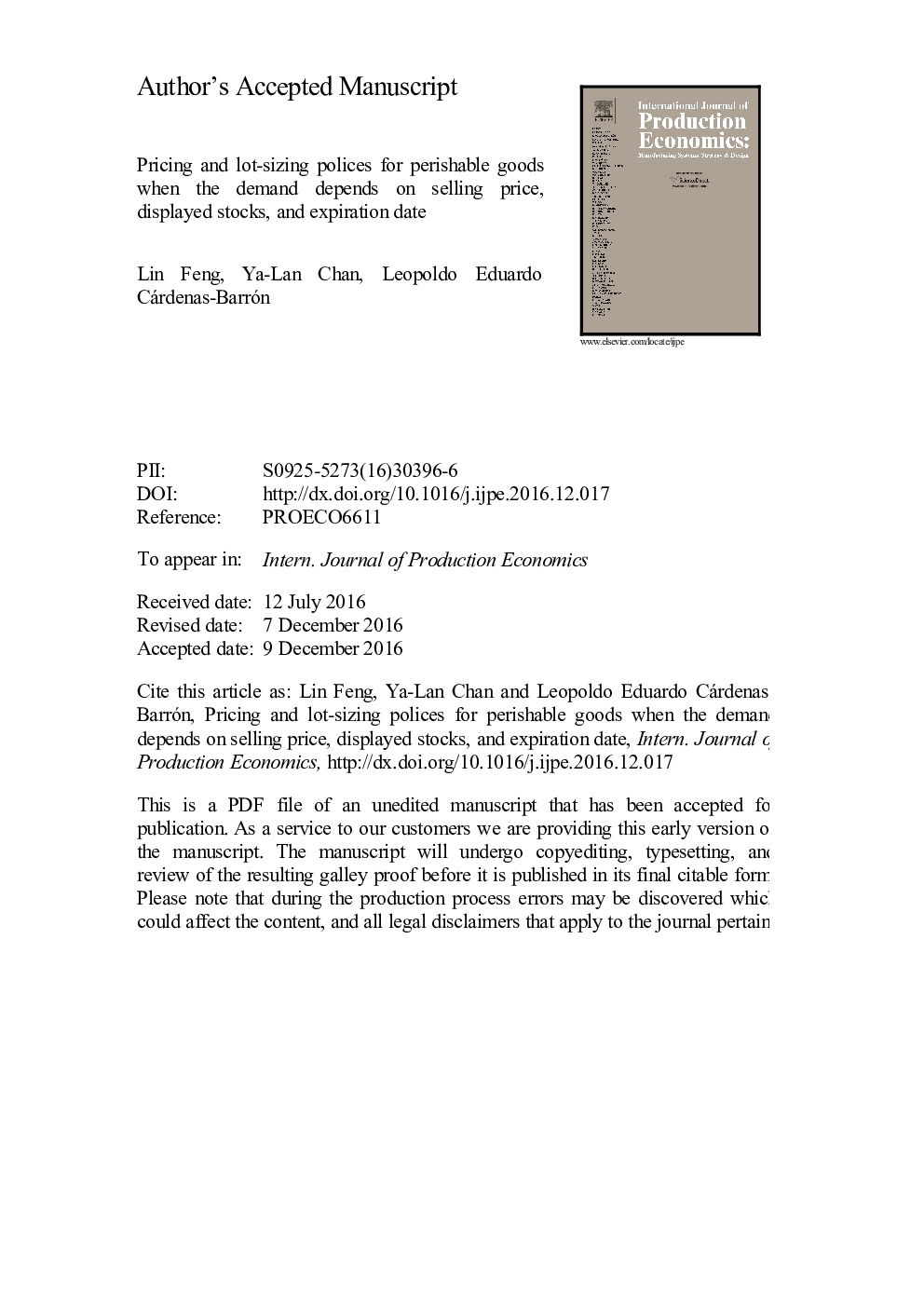| کد مقاله | کد نشریه | سال انتشار | مقاله انگلیسی | نسخه تمام متن |
|---|---|---|---|---|
| 5078970 | 1477519 | 2017 | 35 صفحه PDF | دانلود رایگان |
عنوان انگلیسی مقاله ISI
Pricing and lot-sizing polices for perishable goods when the demand depends on selling price, displayed stocks, and expiration date
ترجمه فارسی عنوان
قیمت گذاری و سیاست های اندازه گیری برای کالاهای فاسد شده زمانی که تقاضا به قیمت فروش، سهام نمایش داده شده و تاریخ انقضا بستگی دارد
دانلود مقاله + سفارش ترجمه
دانلود مقاله ISI انگلیسی
رایگان برای ایرانیان
کلمات کلیدی
کنترل انبار، قیمت گذاری، لات اندازه، محصولات فاسد تاریخ انقضا،
ترجمه چکیده
قیمت عامل اصلی تقاضا بر اساس نظریه بازاریابی و اقتصادی است. علاوه بر این، تقاضا برای محصولات فاسد شدن نیز بستگی به طراوت آن دارد. علاوه بر این، یک واقعیت مشهور است که افزایش نمایش سهام (مثلا میوه های تازه، سبزیجات، محصولات پخته شده) ممکن است مصرف کنندگان را به خرید بیشتر تشویق کند. این مقاله ابتدا مدل موجودی را ارائه می دهد که تقاضا را به صراحت در عملکرد چند متغیره قیمت، نوآوری و سهام نمایش داده می شود. ممکن است مفید باشد که فروش پایانی را در قیمت تخفیف داشته باشید و همیشه در صورت عرضه تقاضا، وابستگی تازه و سهام، همیشه سهام نمایش داده شده در دست خود را تازه و فراوان نگه دارید. از این رو، فرض سنتی موجودیت صفر پایان به موجودی غیر صفر پایان می یابد. به عنوان یک نتیجه، هدف، تعیین سه متغیر تصمیم (به عنوان مثال قیمت واحد، زمان چرخه و سطح موجودی موجود) برای به حداکثر رساندن سود کلان است. سپس نشان داده شده است که مجموع سود در این سه متغیر تصمیم گیری تقریبا شبه مخروطی است که جستجو برای راه حل ها را به یک حداکثر حداکثر محلی محدود می کند. در نهایت، نمونه های عددی برای نشان دادن نتایج نظری و برجسته کردن بینش مدیریتی ارائه شده است.
موضوعات مرتبط
مهندسی و علوم پایه
سایر رشته های مهندسی
مهندسی صنعتی و تولید
چکیده انگلیسی
Price is a major factor on the demand based on marketing and economic theory. In addition, the demand for perishable products also depends on its freshness. Moreover, it is a well-known fact that increasing stock display (e.g., fresh fruits, vegetables, baked goods) may encourage consumers to purchase more. This paper first proposes an inventory model that stipulates the demand explicitly in a multivariate function of price, freshness, and displayed stocks. It may be profitable to have a closeout sale at a markdown price, and always keep on-hand displayed stocks fresh and plentiful if the demand is freshness-and-stock dependent. Hence, the traditional assumption of zero ending inventories is relaxed to a non-zero ending inventory. As a result, the objective is to determine three decision variables (i.e., unit price, cycle time, and ending-inventory level) in order to maximize the total profit. Then it is demonstrated that the total profit is strictly pseudo-concave in those three decision variables, which reduces the search for solutions to a unique local maximum. Finally, numerical examples to illustrate the theoretical results and to highlight managerial insights are presented.
ناشر
Database: Elsevier - ScienceDirect (ساینس دایرکت)
Journal: International Journal of Production Economics - Volume 185, March 2017, Pages 11-20
Journal: International Journal of Production Economics - Volume 185, March 2017, Pages 11-20
نویسندگان
Lin Feng, Ya-Lan Chan, Leopoldo Eduardo Cárdenas-Barrón,
